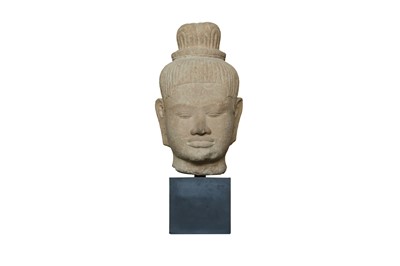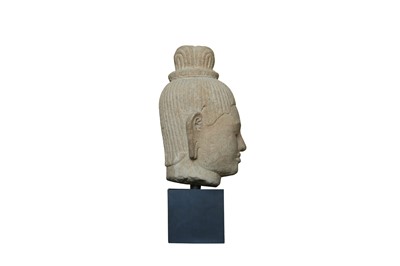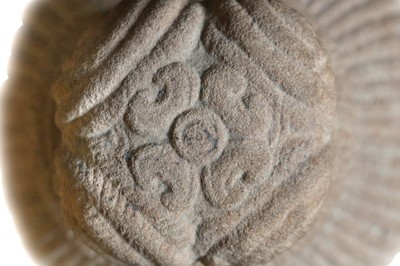29th Apr, 2022 13:00
Islamic & Indian Art
A KHMER CARVED BUFF SANDSTONE HEAD OF THE HINDU GOD SHIVA
Cambodia, South East Asia, Baphuon Style, circa 1010 - 1080
A KHMER CARVED BUFF SANDSTONE HEAD OF THE HINDU GOD SHIVA
PROPERTY FROM THE LATE JEAN-PIERRE YONAN COLLECTION
Cambodia, South East Asia, Baphuon Style, circa 1010 - 1080
Carved in the round on four sides, possibly from a once free-standing statue, the rounded face of Shiva marked by a stern and contemplative expression, the sculpture featuring typical characteristics of Khmer Baphuon style creations like fleshy, full lips, almond-shaped eyes, a wide flattened nose, and elongated earlobes, the hair arranged in matted thick braids and pulled up in a tight high bun kept in place by a decorative jewelled hair-ring, possibly a necklace of rudraksha beads, the dried seeds traditionally carried by Shaivite ascetics, in the centre of the bun a stylised rosette or lotus flower, the austerity and simplicity of the iconographic vocabulary in line with the aesthetic of asceticism promoted in the Baphuon period, mounted on a black stand, 43.5cm high including the stand.
Provenance: In the private collection of Jean-Pierre Yonan in his London flat since the 1980s - 1990s.
During the Baphuon period (1010 - 1080), the main practiced religion in Cambodia was Hinduism with a predominant orientation towards Shiva's cult. Khmer sculptures of this period are imbued with austerity, often expressed in stern looks; a predilection for stasis and perfect symmetry, rendered with flat, full-on, stiff standing postures; a deep feeling of gravitas and internal contemplation, deprived of the serenity and contentment emotion transmitted by later creations in the Angkor period lighten up by their 'Angkor smiles'; and most importantly, the focus is on the representation of the aesthetic of asceticism, promoted by the example of Lord Shiva himself.
Although in a fragmentary state, our head can be compared to some outstanding standing Shiva sculptures attributed to the Baphuon period and published in the publication by W. Felten and M. Lerner, Thai and Cambodian Sculpture from the 6th to the 14th centuries, 1988. In particular, the hair braiding style; the rudraksha jewelled band; the symmetrical arrangement of the hairline around the temples; and the wide flat forehead show great affinity to sculptures cats. 22 and 27 (pp. 206 - 207 and 213 - 214). A similar sandstone figure of Shiva attributed to the Baphuon style once belonged to the Asian art collection of Robert H. Ellsworth, sold at Christie's New York, 17 March 2015, lot 24.
Dimensions: 43.5cm high including the stand
Sold for £3,125
Includes Buyer's Premium
Do you have an item similar to the item above? If so please click the link below to request a free online valuation through our website.





